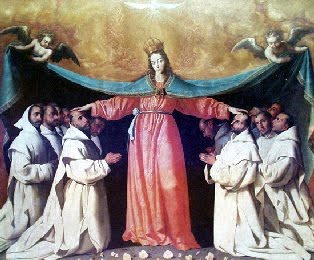 Saint Artold was born around the year 1101 and since his death wasn’t until 1206, he lived about 105 years.
Saint Artold was born around the year 1101 and since his death wasn’t until 1206, he lived about 105 years.As a young man in the year 1120 he entered the Carthusian Charterhouse of Portes. In the year 1140, he was the founder and the initial Prior of the Charterhouse of Arvières which was located in the diocese of Geneva. Ever keeping in his heart the Carthusian vocation, he chose lands from his family which were rugged, snow-covered, and other than animals of the wild, lands that would offer plentiful solitude. Artold, along with others who would join him, built structures made of wood, and lived for ten years there practicing an extremely rigorous ascetical lifestyle.
After a pastoral visit by the Bishop of Geneva, he was so impressed by what he saw that he found a more befitting location for Artold and his monks, and solicited the help of the wealthy in his diocese to help build a monastery for these sons of Saint Bruno.
Saint Artold was the Prior of Arvières for many years and was an excellent spiritual Father for his fellow Carthusians. Eventually, there came the prospect that virtually no Carthusian wants to consider: becoming a bishop. In fact, Artold ran away and tried to keep himself out of sight. When he was found, however, he was made to accept the office of bishop, remarkably at the age of 80, in the diocese of Belley, which is where Artold began his Carthusian vocation at the Charterhouse of Portes.
Since Artold was already at an advanced age when he became bishop, and though he served that office very commendably, he was granted his retirement in the year 1190 by Pope Clement III.
 Afterwards Artold returned to the Charterhouse of Arvières and ten years into his retirement in the year 1200, he was visited there by perhaps the most renowned bishop ever among the Carthusian Order, Saint Hugh of Lincoln. Saint Hugh was present at the peace treaty between the king of England and the king of France; and so, Saint Artold asked Saint Hugh to share his eyewitness account with the other Brothers in the Charterhouse of Arvières. But Saint Hugh said to Saint Artold: “My Lord and Father, although it is legitimate for bishops to hear and relate such matters, it is not so for monks. It is not right to bring news from outside into the cloister or the cell, and to leave the city in order to discuss secular matters in solitude.” Artold found the bishop of Lincoln’s statement to be edifying and full of heavenly wisdom.
Afterwards Artold returned to the Charterhouse of Arvières and ten years into his retirement in the year 1200, he was visited there by perhaps the most renowned bishop ever among the Carthusian Order, Saint Hugh of Lincoln. Saint Hugh was present at the peace treaty between the king of England and the king of France; and so, Saint Artold asked Saint Hugh to share his eyewitness account with the other Brothers in the Charterhouse of Arvières. But Saint Hugh said to Saint Artold: “My Lord and Father, although it is legitimate for bishops to hear and relate such matters, it is not so for monks. It is not right to bring news from outside into the cloister or the cell, and to leave the city in order to discuss secular matters in solitude.” Artold found the bishop of Lincoln’s statement to be edifying and full of heavenly wisdom.Even today, there are no radios, televisions of secular publications in a Carthusian Charterhouse.
After Saint Hugh’s visit, Artold lived about six more years. In his final words to his Brothers he said: “Grow in virtue in order that the sanctity of this House may last forever, passing on its good traditions to those who come after you. Love one another that charity may be the bond at all times uniting you to all in Jesus Christ.” He also told them to rely on the Holy Spirit for Light and comfort, our Blessed Lady for protection, and Saint Bruno as their model.
Miracles occurred when his intercession was sought and in the year 1834 Pope Gregory XVI permitted Saint Artold’s feast to be celebrated in the diocese of Belley and in 1857 the authorization was extended to the Carthusian Order.
Miracles occurred when his intercession was sought and in the year 1834 Pope Gregory XVI permitted Saint Artold’s feast to be celebrated in the diocese of Belley and in 1857 the authorization was extended to the Carthusian Order.











